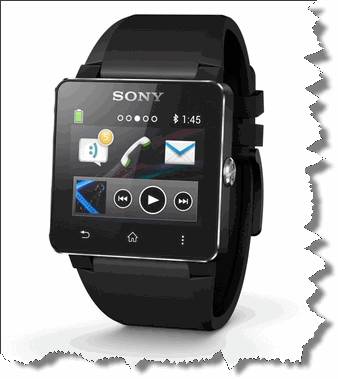This blog recently took a look at the lead Sony has in the wearable device market which is currently only a minuscule overall market. But according to Forrester, 30% of consumers are interested in wearables. All the big boys – Apple, Google, Microsoft, Samsung among the computing leviathans are openly or otherwise working on wearables. But Sony has had a product, Smart Watch, on the market for nearly a year. And Sony Smart Watch version 2 will be out before the rest in September at an unannouced price point.
The improvements have been large scale in some categories and incremental in others. For example the screen resolution has inncreased by 240% allowing the Android UI to be used replacing the Sony UI of SmartWatch1. But the old SmartWatch1 apps run in SmartWatch2. And installing apps has been made easier with NFC based transfers.
But more importantly Sony insists it has expanded significantly the list of Android smartphones that can interact with SmartWatch 2 – but still has no integration with iPhone, Blackberry or Windows Phone 8. Also Sony is promising more new apps
Because I wear my watch when I shower or swim it was interesting to see that Sony made the SmartWatch 2 water resistant – but not shower-able or swimmable. SmartWatch 2 has gained 8gm in weight but now sports more wearable options including attach clips and more watch band choices.
| Comparison of SmartWatch1 vs SmartWatch 2 | ||
| Category | SmartWatch 1 | SmartWatch 2 |
| Display | 128×128 LCD | 220 x 176 TFT |
| OS and UI | Android,Sony | Android for both |
| Water Resistant | No | Yes |
| Battery Life | ~ 3 days | ~ 3.5 days |
| Connections | Bluetooth 3, GPS | Bluetooth 3, GPS, NFC |
| Links to | Limited Android phone | Wider array of Android phones |
| Price | $120 | ?? |
The question now is this enough to sustain and grow the wearble and possibly broader attachable market in Sony’s favor. Consider that the Apple iPod Nano delivers 256 x 256 TFT screens right now.Or that Samsung has started delivering tiny phones with great screen-size [480 x 320] and features at impressive price points – $50-100. Even more impressive is Samsung’s agile product development cycle – Samsung often enters a market with 3-5 prototypes with different feature options and refines that down to a winning line-up within a year or two at most. In short, Sony may have satisficed – and not been innovative enough. It is amazing to say this about the electronics pioneer of the past 30 years.

